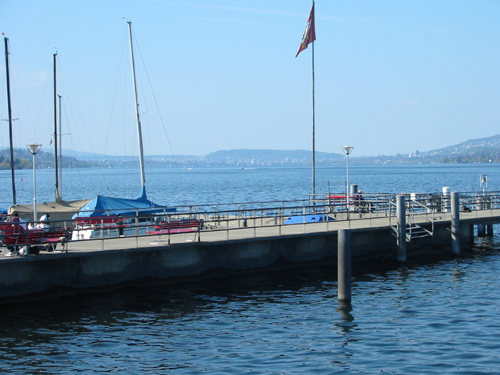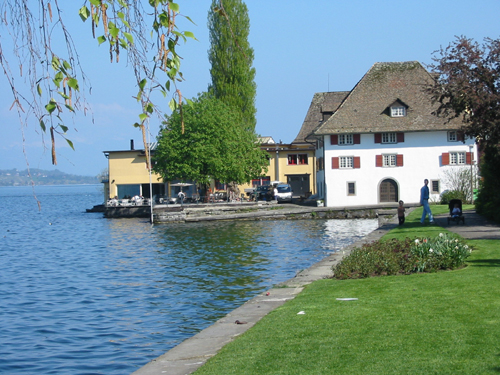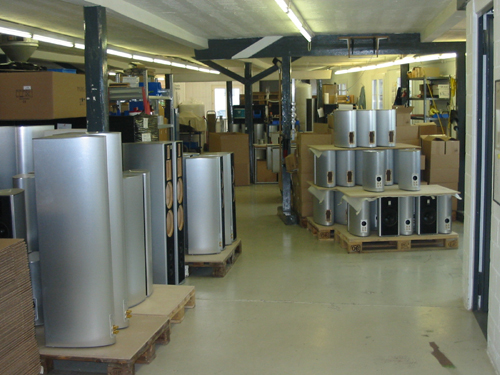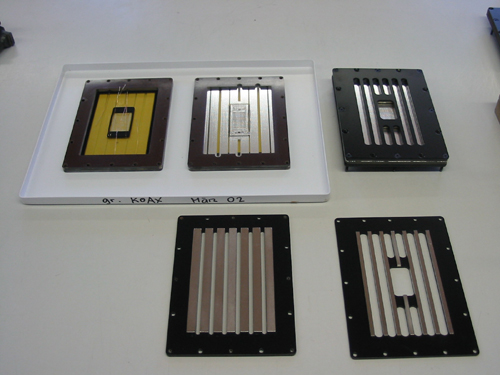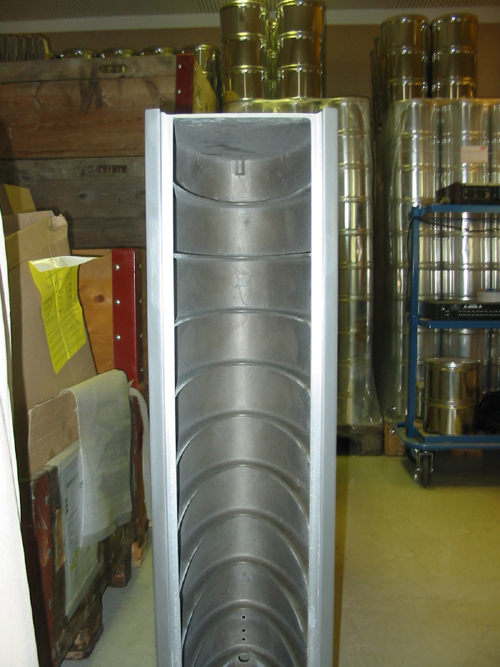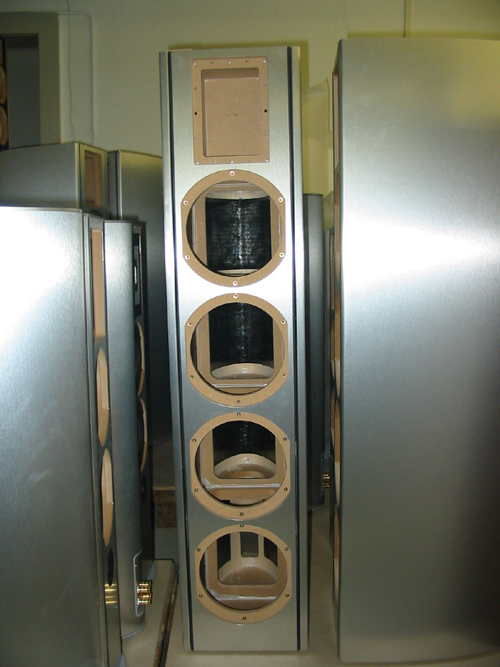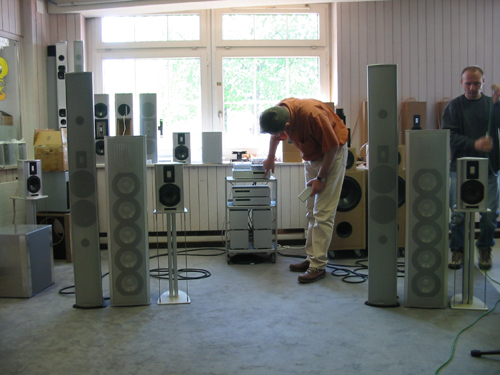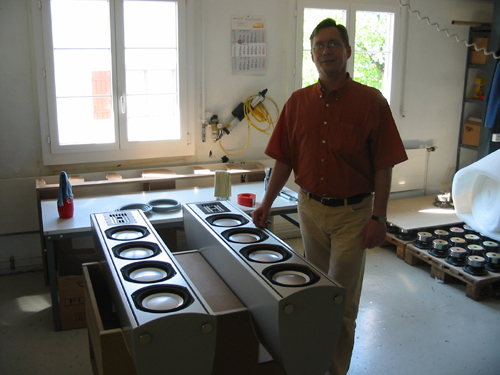|
You are reading the older HTML site Positive Feedback ISSUE 13may/june 2004
Piega Factory Tour Spring 2004
On a sunny Monday afternoon I embarked on a quest to see what famous Swiss engineering is all about. Piega is truly a Swiss company comprising approximately 20 employees nestled along the shores of the beautiful lake Zürich. It was in this relaxing environment that I embarked on my first ever tour of a high end audio company. Mr. Carlo Struchtrup, Piega's export director, was my tour guide that began by simply walking through factory. What I saw was quite a surprise as the majority of the space inside the factory was floor-to-ceiling with boxes! Boxes of what you ask? Well drivers (many sourced from Peerless), crossovers, and empty loudspeaker cabinets waiting to be assembled.
Not a bad view to have from the old office! Before beginning the tour proper, Carlo and I sat down and discussed the philosophy of Piega and some facts about the company. During this conversation I was informed that all Piega loudspeakers are built there in the factory and that for all models, some 14,000 loudspeakers per year are assembled. For some companies this may not be such a large number but when one considers that Piega only employs 20 people this means some rather efficient processes for speaker building are being implemented. Carlo informed me that Piega, while very much on the cutting edge of technology with their new concept of a coaxial planar magnetic driver and non-rectangular boxes, is still quite conservative in many ways and that they rely heavily on science and good engineering principles in their loudspeaker designs. Measurements figure very heavily into the design process as well as proper cabinet construction and crossovers using very high quality parts. As many of you dear readers know, Piega is famous for their planar magnetic tweeter (its not a ribbon in the truest sense). More recently, Piega began also making a push-pull planar magnetic midrange. Still, according to Carlo, they felt that their design goals of flat frequency response and good overall top to bottom coherence with good off-axis dispersion could only be met by making the midrange and high frequencies coaxial. This is not such an unusual view point (British brands KEF, Tannoy, and Thiel have been implementing this concept for a long time) to have. What is unusual about Piega's approach to this concept is the implementation of a truly flat coaxial driver, which is the only driver of its kind in the world.
Nice place to build world class loudspeakers! When I asked Carlo why he thought no one else had built such a driver before, he said that he felt it had to do with the difficulties in design and especially construction (more on that in a moment) that deterred companies from pursuing this concept further.
Ground floor of the factory with many unfinished boxes awaiting completion.
Disassembled coaxial planar driver. The magnets are so powerful that they actually bend the end plates! Mr. Structrup then took me to where these impressive drivers are made. It was a small workshop and I was informed that the process of construction is done entirely by hand and only 2 or 3 people in the entire company know how to build them. One such person, Mario, is in the photo below. I was told by Mario that he can build around 8 of these planar coax drivers per day. The design was conceived by on of the company's founders, Kurt Scheuch, and more than one year was spent in perfecting the design. It is quite ingenious design where both drivers are chemically etched onto the same sheet of metal coated Kapton®. The two drivers are then separated from each other by cutting slots in the plastic along the sides of the tweeter section. The two drivers are then further decoupled by the use of neoprene rubber (look at the yellow backside of the driver in the top left hand and notice the black square in the middle of the driver) to prevent intermodulation distortion in the tweeter. The magnets used are the very powerful NdFeB type and are extremely difficult to handle properly. Carlo informed that the magnets were provided by a local Swiss supplier because of the high tolerances demanded for this application. When I inquired as to why they don't use a less expensive source for the magnets, Carlo said that they had tried some Chinese made magnets but the quality of them was inadequate for their driver. The midrange section is of the push-pull variety, whereas the tweeter is a single ended design with the magnets to the rear. This leaves the front completely open and prevents problems with diffraction at the shorter wavelength high frequencies. I then asked them if there would be a problem with non-linearity by running the tweeter single ended. They said that due to the small motion of this driver that the distortion was in fact quite low. Impressively, the driver has a frequency range from 400Hz to 20Khz (300 to 20Khz on the C40's version) and is phase coherent (using only a very minimal crossover). Finally, I was shocked to learn that unattenuated this driver has a sensitivity of nearly 104db/watt!
Mario brandishing a finished coaxial driver With that part of the tour complete, Carlo directed me to some of the more interesting elements of the cabinet design employed by Piega. From what I gather all of the cabinets are designed by Piega but then the construction is outsourced to contractors in Switzerland. This saves a bit on the cost of keeping and maintaining a full machine shop but to have the cabinets made in Switzerland still makes them very expensive. Also, the design and complexity of such cabinets adds much to the manufacturing cost. Cutting corners does not seem to be an option at Piega. I was of course most impressed with the cabinet of the model C40, which you can see the above photo. It is made as a single cast piece of aluminum, shaped roughly like a letter C (thus the series name), with internal ribs to increase cabinet rigidity. Still, when untreated the cabinet will ring quite loudly (but with a dull ring and not like a brass bell) and for quite some time. Carlo demonstrated briefly how the cabinet is properly damped. Strips of very dense asphalt like compound are placed in between the ribs around the full diameter of the cabinet. In addition, cross braces are added to increase the stiffness even further. With the addition of these strips, cross bracing , and a solid face plate for driver mounting, Piega ends up with a speaker cabinet that is about as dead as any I have rapped with my knuckles.
Inside of an unfinished C40. Yes folks that's solid aluminum! The other cabinets in the C ltd. lineup are not quite as extreme as the C40 in that they do not use a solid aluminum cabinet but they are still the result of a serious attempt to take the cabinet out of the musical equation. For the remaining models a cabinet of 15 layers of wood, sandwiching a thin layer of cork makes for a cabinet with virtually no sound. Furthermore, the inside is extensively braced in a manner reminiscent of the B&W Matrix®. Finally, the same bitumen damping strips are placed all along the inside. What then is the result of such heroic construction? Simply knuckle busting but very little sound from the cabinet itself. The remaining part of the tour was spent oogling various crossover boards, which use only top quality passive components (for you component freaks out there, I am sorry but the names elude me) and various details that go into finishing the product. Still, for me the proof is in the pudding, so to speak, and it was time to fire up some speakers and give a listen.
Awaiting final assembly is an unfinished Piega C10 ltd. While its not all metal as with the C40 above, the internal construction is still heroic (note the bitumen damping and matrix like crossbracing). Naturally, Carlo wanted me to hear the best that Piega has to offer and so with eager ears he played some cuts on a beautiful pair of Piega C40's with black piano lacquer all around the sides and back. The resultant sound is clearly of an extremely high caliber with the kind of smooth and unforced detail that let's you know there are no nasties (typically cabinet related) to be found in this speaker. Bass was tight and powerful but not earth shattering and there was naturalness to the sound that made listening easy. The word "resolution" came to mind several times while listening to these admittedly VERY expensive loudspeakers.
Ah! I was treated to a listening session with the top model the C40 ltd. (the middle speaker with 5 cone drivers). Spinning the CDs was my host Carlo Struchtrup, director of exports. All in all, it was a highly enjoyable and educational tour of how loudspeakers are built, Swiss style. I was impressed by Piega's organization and how they seem to know exactly which items should be done in house and which items should be outsourced to maximize their efficiency and quality. The quality of product I was shown on this tour bespoke of the famous Swiss quality in every detail. Impressive! I would like to thank Carlo for being a very fine host and for providing me with a wealth of information and insight into how the ultra-modern loudspeaker comes into being.
Carlo is posing for the camera with a brand spankin' new pair of C10s. Peiga Loudspeakers http://www.piega.ch
|

